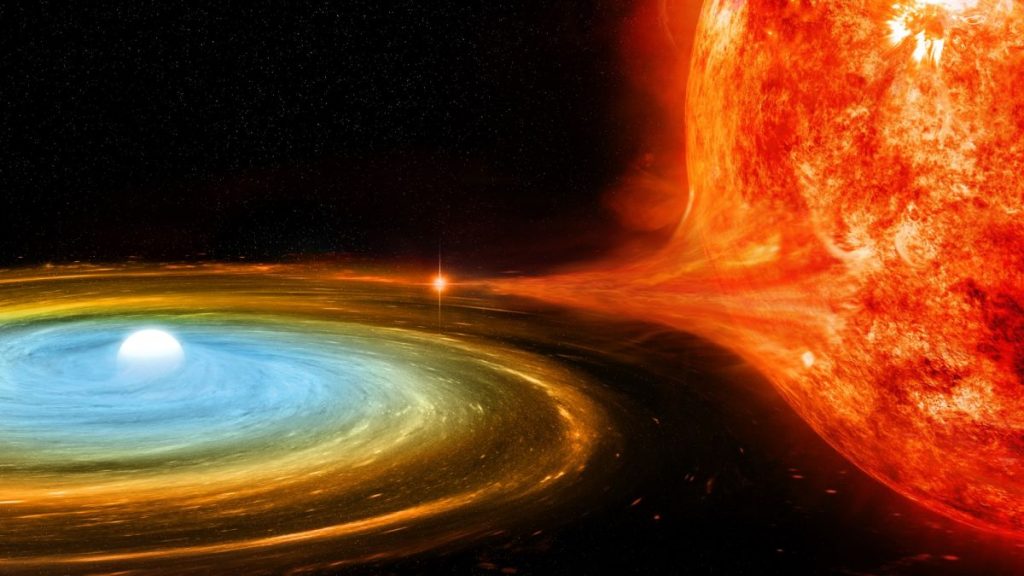Astronomers observing the fastest nova ever recorded have discovered that it reverberates periodically like a struck bell, with the unusual energetic phenomenon driven by a white dwarf feeding from a companion star.
The strange binary star system and the nova — designated V1674 Hercules and located in the constellation Hercules — could be the key to a better understanding of the chemistry of the solar system, the birth and death of stars and even the evolution of galaxies. V1674 Hercules first erupted on June 12, 2021, resulting in a burst of light so bright it was visible to the naked eye. Scientists identified the outburst as a nova, a sudden flare of bright light in a two-star system in which a white dwarf — a stellar remnant left over when a small or medium star runs out of nuclear fuel and sheds its outer layers — is dragging material away from a companion star.
As this matter falls to the surface of the white dwarf it heats up, leading to an explosive reaction that launches material away at speeds approaching that of light. The reaction also creates energetic electromagnetic emissions that can be seen as visible light.
Supernova photos: Great images of star explosions
While these events usually fade over a period of a few weeks or even longer, V1674 Hercules was remarkable because it went faint quickly, in just over a day. The previous fastest nova faded in a period of between two to three days, and in general rapid novas are rare.
But, the rapid fade wasn’t the only remarkable thing about this system, according to new research on the nova, which determined that the energy and light output of V1674 Hercules is reverberating like a rung bell. And the “wobble” — which occurs every 501 seconds and can be seen in both visible and X-ray light — continues a year after the initial explosion.
“The most unusual thing is that this oscillation was seen before the outburst, but it was also evident when the nova was some 10 magnitudes brighter,” Mark Wagner, an astronomer at Ohio State University and co-author on the new research, said in a statement. “A mystery that people are trying to wrestle with is; what’s driving this periodicity that you would see it over that range of brightness in the system?”
The researchers also found that as the nova blast ejects material, the outflow is being shaped by a “wind” that seems to depend on the position of the system’s white dwarf.
“We are still observing the system. We know that the white dwarf has not returned to quiescence,” Sumner Starrfield, an astronomer at Arizona State University and co-author on the research, told Space.com. “We also know that mass is being lost at one orbital phase. But we are getting more data to determine where in the orbit it happens. Is it when the white dwarf is in front or when the secondary star is in front or when the system is in some intermediate phase?”
In a talk delivered at the American Astronomical Society (AAS) meeting in California on Tuesday (June 14), Starrfield revealed that he and the team believe that this binary is an intermediate polar system, which occurs when a white dwarf feeds from a companion star but the white dwarf’s own magnetic fields disrupts the feeding, causing the light and energy of the system to fluctuate.
The nature of this kind of system is only one of the puzzles that astronomers could use V1674 Hercules to help unlock.
What can V1674 Hercules show astronomers?
Understanding this system could give astronomers important insight into how galaxies evolve because the material that novas eject spreads through surrounding space. Ejected material goes on to form the next generation of stars and planets — including our sun and the entire solar system, and different types of novas from different stars disperse different abundances of elements.
“We’re always trying to figure out how the solar system formed, where the chemical elements in the solar system came from,” Starrfield said. “One of the things that we’re going to learn from this nova is, for example, how much lithium was produced by this explosion. We’re fairly sure now that a significant fraction of the lithium that we have on the Earth was produced by these kinds of explosions.”
White dwarfs in binary systems can also provide an important measuring tool for astronomers. This property arises because not all the material white dwarfs steal from their companion star is ejected in nova explosions; some of it remains, resulting in the white dwarf gaining mass. This gain can push ithe white dwarf past what scientists call the Chandrasekhar mass limit, the dividing line between stellar remnants that can’t go supernova and ones that can.
A white dwarf that exceeds this limit can eventually erupt in a type 1a supernova, which is not only one of the brightest events in the universe but one that has a light output that is so regular and uniform that scientists use these events, often nicknamed “standard candles,” to accurately measure distances.
A better understanding of both nova and supernova explosions could also give researchers a better idea of the processes that occur at the end of stars’ lives, when they run out of fuel for nuclear fusion.
But first, astronomers including Starrfield need to study V1674 Hercules further. In particular, Starrfield said, he hopes to use the Large Binocular Telescope in Arizona to photograph the gases spit out by the system to understand how the explosion occurred.
“This is totally a work in progress,” he said.
The research is described in a paper that has been accepted for publication to the journal Research Notes of the American Astronomical Society.
Follow us on Twitter @Spacedotcom and on Facebook.

